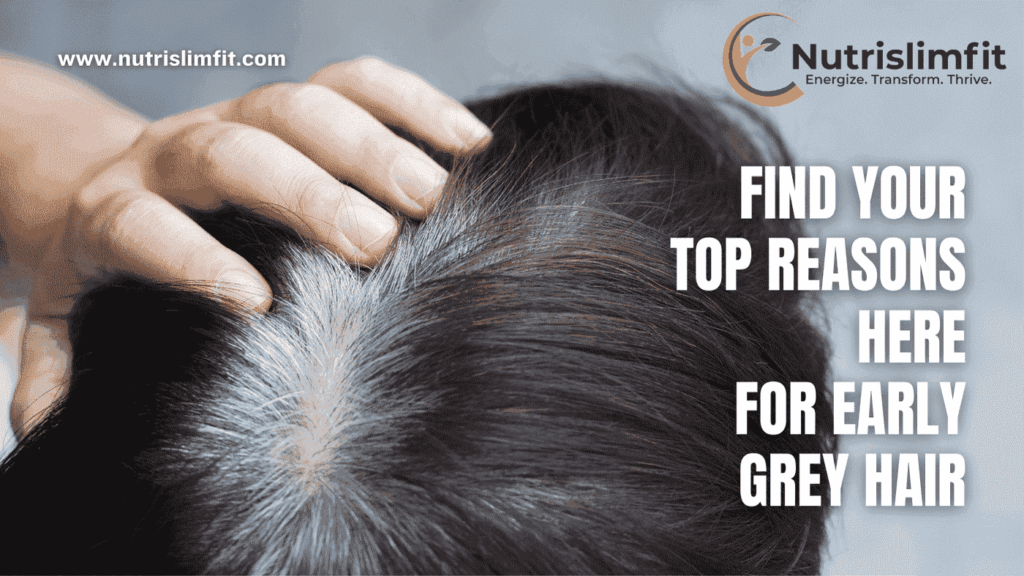Grey hair is caused by a loss of melanin, the pigment that gives hair its color. While some grey hairs as we age are normal, getting premature graying before age 30 is concerning for many. There are a variety of factors that can contribute to premature greying. Understanding what causes early onset graying can help you take steps to potentially slow down or cover up the process.

Genetics
Genetics plays a significant role in whether someone will go grey early. People whose parents or grandparents went grey at a young age are more likely to follow the same pattern.
The gene IRF4 seems to be associated with hair color. Variations in this gene likely influence when greying begins and how quickly it develops. While you can’t change inherited genes, being aware of your family history can help set realistic expectations.
Oxidative Stress
Oxidative stress occurs when there is an imbalance between free radicals and antioxidants in the body. Too many free radicals can damage melanin-producing cells (melanocytes), causing them to stop producing pigment.
Several lifestyle factors can increase oxidative stress levels:
Smoking
The chemicals from smoking accumulate in the body, triggering inflammation and free radical damage throughout the body – including the pigment-producing cells in hair follicles.
Poor Diet
Diets low in antioxidants can allow free radicals from normal metabolism, pollution, and other sources to damage cells unchecked. Ensuring you eat plenty of antioxidant and vitamin-rich foods can help balance excess free radicals.
High Stress Levels
Stress causes the body to produce stress hormones like cortisol. In small amounts these hormones are helpful, but chronic stress leads to excessive levels which contribute to oxidative damage. Finding healthy stress relief practices like exercise, meditation or yoga can mitigate some effects.
Sun Exposure
UV radiation from the sun can react with cells and molecules in the skin to produce free radicals. You can help avoid excessive sun exposure by using shade, protective clothing, and hats when outside for long periods.
Autoimmune Disorders
The immune system is supposed to protect the body from foreign invaders. But sometimes it can mistakenly attack healthy tissue – known as an autoimmune problem.
In the case of hair, this can involve the immune system destroying the melanocyte cells – preventing new pigment formation. Examples of conditions tied to premature greying include:
- Alopecia areata – causes patchy hair loss, often starting with grey hairs.
- Vitiligo – causes depigmentation of areas of skin, with white patches and early graying.
- Thyroid disorders – the thyroid gland regulates many body functions, and autoimmune diseases can cause hormone fluctuations.
Treating any underlying autoimmune condition may help slow or stop premature greying.
Vitamin B12 Deficiency
Vitamin B12 plays an important role in the normal functioning of blood cells, nerves, the brain, and more. Low levels affect many body processes – including melanin production.
Since B12 is primarily found in animal foods, vegetarians, vegans and those with poor absorption may become deficient. Taking supplements can often reverse associated symptoms, but more research is still needed on whether supplementation stops greying.
Emotional Stress and Trauma
You’ve probably heard stories of people’s hair turning white “overnight” after a traumatic event. Extreme physical stress from a severe illness or accident has also been occasionally tied to rapid greying. The phenomenon has not been studied extensively, but intense emotional strain could trigger hormonal and immune changes impacting melanin.
While you can’t always avoid emotional trauma, having a strong support system, healthy outlets like therapy, and stress resilience skills can mitigate harmful effects on your body.
When to Seek Medical Evaluation
In some cases, premature greying can be caused by an underlying medical condition requiring treatment. It’s a good idea to discuss your hair changes with a doctor if they are:
- Occurring before age 20
- Developing very rapidly over several months
- Involving extensive shedding or hair loss
- Accompanied by other symptoms like fatigue, pain, or changes elsewhere in the body
Testing can help determine if an illness like an autoimmune disorder, hormone imbalance, or nutrient deficiency is responsible so that proper treatment can begin.
Can Early Greying Be Prevented?
While you can’t entirely control when greying begins or progresses, making healthy lifestyle choices may help delay the onset and slow the process.
Stress Management
Chronic emotional strain and high cortisol levels seem to accelerate greying for those genetically predisposed. Relaxation practices like meditation, yoga, massage, and getting adequate sleep help keep stress under control. Maintain fulfilling relationships and take time for hobbies you enjoy as well.
Diet
Antioxidants help combat oxidative stress driving greying. Eat plenty of brightly colored fruits and vegetables high in vitamin C, vitamin E, beta-carotene, lycopene, and other antioxidants.
Also make sure you get adequate B vitamins by including whole grains, meat, fish, eggs, and leafy greens. Consider supplements if blood tests confirm a nutritional deficiency.
Smart Sun Exposure
Small amounts of midday sun exposure allow vitamin D production essential for health. However excessive UV radiation degrades melanin over time. Wear sunscreen and protective clothing even on cloudy days, use an umbrella at the beach or park, and avoid extended sun exposure when rays are most intense.
Avoid Smoking and Pollution
Don’t smoke, and limit exposure to secondhand smoke as well as vehicle exhaust and indoor toxins from chemicals to reduce free radical damage. Drink plenty of water to flush out what you can’t avoid.
Scalp Massage
Some natural health practitioners recommend frequently massaging the scalp with oils thought to benefit hair health – like olive, coconut, almond, or castor oils. No studies prove oil treatments prevent or reverse greying. However, scalp massage feels relaxing and may boost circulation. Trying oils or dry massage couldn’t hurt.
Can Greying Hair Be Reversed?
Once hair has already turned grey, melanin production usually won’t spontaneously resume. However, treatments are available to cover grey strands.
Hair Dyes and Colors
Dyeing grey hair is the most common cosmetic approach. Permanent chemical dyes penetrate the hair shaft to deposit or remove pigment, while semi-permanent coats the outside of hair with pigmented molecules. Consult a stylist to determine what option is best for your hair type and lifestyle. Be aware that harsher chemicals may damage delicate greying hair.
Natural Dyes
Plant-based dyes like henna and black tea are gentler alternatives to harsh chemical dyes, though still not permanent. Experiment to find a formula that covers grey well. Repeat applications are needed as new growth comes in.
Bleaching Surrounding Hair
Instead of applying color solely to grey strands, some opt to lighten all their hair with bleach or peroxide products so the difference blends more seamlessly. Highlights or ombré designs can disguise unwanted grey patches. But bleaching is damaging, so use the gentlest formulas and do occasional conditioning treatments.
Embracing and Enhancing Grey Hair
Dyeing to match your original color is not the only option. More people are embracing grey locks as a chic, striking look nowadays. Going fully or partially grey may give hair added dimension and sheen.
Silver Fox
Men with grey hair giving them a “salt and pepper” or completely silver fox look are considered sexy and distinguished. Crew cuts, faux hawks or simply keeping hair trimmed fairly short allows grey strands to stand out.
Highlights
Rather than evenly coloring hair, streaks or panels of lighter grey highlights against a darker base make greying seem purposeful. The contrast appears trendy and fun.
Lowlights
The opposite approach involves using dye or rinses on certain sections to make them darker while leaving most hair grey. This prevents the overall dulling effect some grey hair develops over time.
Conditioning Treatments
Grey and white hair tends to become dry and coarse faster than pigmented strands. Using a hair mask for extra moisture and products containing oils or silicones can make hair softer, shinier, and easier to manage. A little extra sheen keeps the look modern rather than aging.
Embracing your emerging salt and pepper or pewter shade can reduce the time and money spent hiding it. Flaunt greying locks as a mark of your maturity, wisdom, and life experiences.
Final Thoughts
Going grey prematurely can initially seem stressful or alarming. But understanding what lifestyle factors drive early greying allows you to take preventative steps like reducing stress and improving your diet when possible. In cases caused primarily by hereditary or health factors outside your control, focus on making healthy choices that support well-being overall.
While reversing established greying isn’t feasible, strategic coloring, highlights, conditioning, and styling lets you conceal, blend, or accentuate grey hair in flattering ways. Rather than viewing greying as an unwelcome sign of aging to fight at all costs, adjust your mindset to embrace and enhance your new hair color. Grey strands can even become an appealing signature look when cared for properly. What matters most is appreciating the wonderful body you have at every age. Prioritize feeling happy


